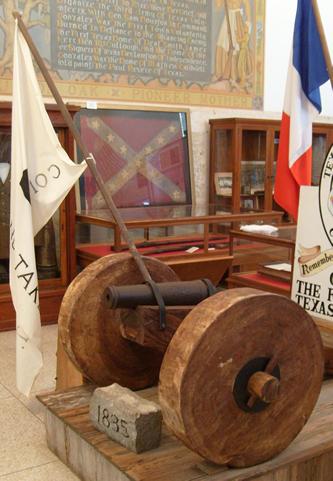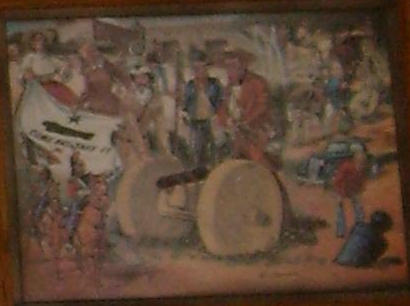|
Books by
Jeffery Robenalt
|
|
|
During
the first few years of its newly won independence, Mexico followed
Spain’s policy of strictly limiting Anglo-American settlement in
Texas. However, after adopting the
Constitution of 1824, the Mexican government liberalized the immigration
policy, and in 1825, American Green DeWitt received
permission to settle 400 families in central Texas near the confluence
of the San Marcos and Guadalupe Rivers.
From the inception of Dewitt’s colony, the settlers were plagued
by attacks from both local Native American tribes like the Karankawas
and the Tonkawas,
and from the more distant and fierce Comanches. The attacks continued
unabated for more than a year, culminating in the burning of Gonzales
which served as the capital of the colony. Seeking to bring an end
to the violence, DeWitt negotiated a peace treaty with the Karankawas
and Tonkawas, and
the town was rebuilt, but the Comanches continued to raid the colony
on a regular basis.
In
1831, the colonists sought help from local Mexican authorities,
but with no troops to spare, the only aid the military was able
to offer was the loan of a small cannon. Though the tiny six-pounder
provided little in the way of defense, other than some loud noise
and smoke, it was to play a key role in future events leading to
the independence of Texas.
|
 |
|
Meanwhile in
Mexico, the
federalists, who believed in the principle of states’ rights, were
involved in an ongoing struggle for control of the government with
the centralists, who desired a strong central government. In 1833,
Antonio Lopez de Santa Anna seized power. Although the Texans
supported Santa Anna at first, believing him to be a federalist,
they soon realized that he failed to share their states’ rights
views on government. Once in power Santa Anna showed his true colors
by dismissing the Mexican congress, annulling the Constitution of
1824, and declaring himself dictator for life.
Unrest grew Throughout Mexico
as Santa Anna began to consolidate his power, and in 1835, several
Mexican states revolted. The revolts were brutally suppressed. In
one instance, the new dictator dissolved the legislature of Coahuila
y Tejas and rewarded his troops with two days of rape and pillage
in the town of Zacatecas.
In June, the political unrest spread to Texas
when the first skirmish between Mexican soldiers and Texas settlers
took place near Anahuac.
In spite of the rising tensions, however, most settlers like those
of De Witt’s colony remained loyal Mexican citizens, although of
the federalist persuasion. Unfortunately, Santa Anna unwisely chose
to ignore this fact and increased tensions further by sending more
troops to Texas under the command of
his brother-in-law, General Martin Perfecto de Cos.
Political opinion in Texas remained
sharply divided. Some settlements, stirred up by revolutionary hot
bloods like William Barrett Travis, supported the rebellion,
while others, including Gonzales,
continued to openly declare their loyalty to Mexico.
Leaders across Texas began to call
for a meeting to determine the true majority view. Although many
people worried that Santa Anna would see such a gathering as a step
toward revolution, by late August most settlements had agreed to
send delegates to a formal Consultation scheduled for October 15.
On
September 10, events began to accelerate when the severe
beating of a Gonzales
resident by a Mexican soldier led to widespread public protests.
Fearing a general uprising, Colonel Domingo Ugartechea, the
commander of the Mexican garrison in San
Antonio, sent Corporal De Leon and a small detachment
of soldiers to retrieve the cannon under the pretense that it was
needed for the defense of the city.
When De Leon arrived in Gonzales
and requested the return of the cannon, a poll was taken among the
residents by the alcalde, Andrew Ponton. The citizens overwhelmingly
voted against returning the cannon, and began preparing for trouble
by moving their families together, gathering supplies, and sending
riders across the countryside to gather the local militias. The
small cannon was buried in a peach orchard for safekeeping.
Upon Corporal De Leon's return to San
Antonio empty handed, Colonel Ugartechea immediately dispatched
Lieutenant Francisco Casteneda to Gonzales
with more than a hundred troops. Instead of requesting the return
of the cannon as before, Lieutenant Casteneda was ordered to demand
its return. At the same time, he was to avoid a confrontation if
at all possible; difficult orders to follow given the tense situation.
|
 |
|
Reaching
the west bank of the Guadalupe River on the morning of September
30, Casteneda found the river running high from recent rains
and all the rafts and barges removed to the east bank. Castenada
requested to speak with the alcalde, but he was informed by the
armed colonists spread out along the east bank of the river that
Ponton was unavailable.
After a frustrating day of shouting across the river accomplished
nothing, Lieutenant Casteneda moved his men to some high ground
300 yards from the river and set up camp for the night. The following
morning, well aware that the size of the Texas force was steadily
increasing, Casteneda moved his camp seven miles further upriver
to a more defensible position near a shallow ford. This was in keeping
with Colonel Ugartechea’s orders to avoid hostile action, but the
Texans failed to interpret the move in that light.
Instead, the colonists saw Casteneda’s move as a threat, deciding
that the Mexican strategy was to either withdraw from Gonzales
to await reinforcements or attempt to force a crossing of the Guadalupe
at another location. Therefore, they decided to take the initiative
and launch their own attack. Once the decision to attack was made,
the colonists spent the day readying weapons and equipment, which
included digging up the small cannon from the peach orchard and
mounting it on a pair of wheels removed from an old cotton wagon.
Since there were no cannon balls, cast iron was cut into hunks of
shrapnel small enough to fit the barrel of the cannon.
On the evening of October 1, a force of about 140 Texans,
under the command of newly elected militia Colonel
John Henry Moore, began to cross the Guadalupe at the Gonzales
ferry landing. Once across the river, the fifty men on horseback
led the way followed by the cannon. The Texans who were on foot
spread out to the flanks and formed a small rear guard. Progress
was slow due to the men on foot, and a thick fog enveloped the Guadalupe
river valley after midnight, delaying the march even further.
Finally, around 3 AM, the colonists reached the area of the Mexican
camp, but a barking dog warned of their approach. The Mexicans on
the perimeter of the camp began to fire blindly into the fog. None
of the Texans were hit, but the loud noise caused one of their horses
to panic and throw its rider. The man suffered a bloody nose as
a result of the fall. After the initial volley, the colonists made
a hasty withdrawal, taking cover in a thick stand of timber near
the Guadalupe River. Lieutenant Casteneda withdrew his men
to a nearby bluff.
|
|
Between the
soupy fog and the early morning darkness, neither force could determine
the exact position of the other, so both sides waited for sunrise.
Fog continued to limit visibility when the Texans finally advanced
from the trees around 6 AM and began firing at the Mexicans on the
bluff. Casteneda immediately retaliated by launching a counterattack
with a small force of cavalry. The Texans again fell back to the
trees along the river, where they fired another volley, wounding
one of the Mexican cavalrymen. Unable to maneuver among the trees,
the Mexican horsemen were forced to withdraw.
When the fog began to lift, Lieutenant Casteneda sent a messenger
to Colonel Moore requesting a meeting. The two commanders met in
full view of both forces, with Moore explaining that the Texans
remained faithful to the Constitution of 1824, but could no longer
recognize the dictatorship of Santa Anna. It is believed that Casteneda
too was a federalist who supported the Constitution, but he had
no choice but to follow his orders. Unable to arrive at a compromise,
Casteneda and Moore returned to their lines.
As Colonel Moore rode in among his men, the Texans fired the small
cannon and defiantly raised a homemade flag with the image of a
cannon and a star painted in black, above the words “Come and Take
It.” The Texans followed up with a volley from their long rifles,
and Colonel Moore led a halfhearted charge toward the bluff. The
charge proved unnecessary, however, because Lieutenant Casteneda,
following his orders not to force an engagement, had already begun
a withdrawal toward San
Antonio.
|
|
|
The
1936 Monument of
the Battle in Cost
TE photo, April 2000 |
|
Although the
Battle of Gonzales was, in reality, nothing more than a minor skirmish,
its political consequences were far reaching. Like the Battle
of Lexington, which initiated the American Revolution, Gonzales
served as the Texas “shot heard round the world.” Texans had at
last taken up arms to defend their rights against Santa Anna’s despotism,
and they had no intention of turning back. Two days after the battle,
Stephen F.
Austin, who had long counseled peaceful negotiation, wrote “War
is declared … public opinion has proclaimed it…”
|
|
Gonzales
became a magnet for all those Texans bitterly opposed to Santa Anna
and his tyrannical policies, and although the fighting at Gonzales
had long since ended, they continued to gather in support of the
revolutionary banner. On October 11, Stephen
F. Austin, in spite of his lack of formal military training,
was unanimously elected to command the “Army of the People.” The
following day he led a march that would grow to nearly 400 men as
it neared San Antonio,
and would eventually culminate in a bloody siege of the old mission
town.
© Jeffery
Robenalt, December 1, 2011 Column
jeffrobenalt@yahoo.com
References
›
About Jeffery Robenalt
More "A Glimpse of Texas Past"
|
References
for The Battle of Gonzales "Come and Take It"
|
|
Barr, Alwyn,
(1990), Texans in Revolt: The Battle for San Antonio, 1835,
Austin, TX, University of Texas Press, ISBN 0-292-77042-1, OCLC
20354408
Davis, William
C. (2006), Lone Star Rising, College Station, TX, Texas A&M
University Press, ISBN 9781585445325, originally published by New
York Free Press
Fehrenbach,
T. R. (2000), Lone Star: A History of Texas and Texans, Cambridge:
Da Capo Press, ISBN 0-306-80942-7
Groneman,
Bill (1998), Battlefields of Texas, Plano, TX, Republic of
Texas Press, ISBN 979-1-55622-571-0
Lack, Paul
D. (1992), The Texas Revolutionary Experience: A Political and
Social History 1835-1836, College Station, TX, Texas A&M Press,
ISBN 0-89096-497-1
Roell, Craig
H. (1994), Remember Goliad! A History of La Bahia, Fred Rider
Cotton Popular History Series, Austin, TX: Texas State Historical
Association, ISBN 0-87611-141-X
Todish, Timothy
J.; Todish, Terry; Spring, Ted (1998), Alamo Sourcebook, 1836:
A Comprehensive Guide to the Battle of the Alamo and the Texas Revolution,
Austin, TX, Eakin Press, ISBN 978-1-57168-152-2
|
|
|
